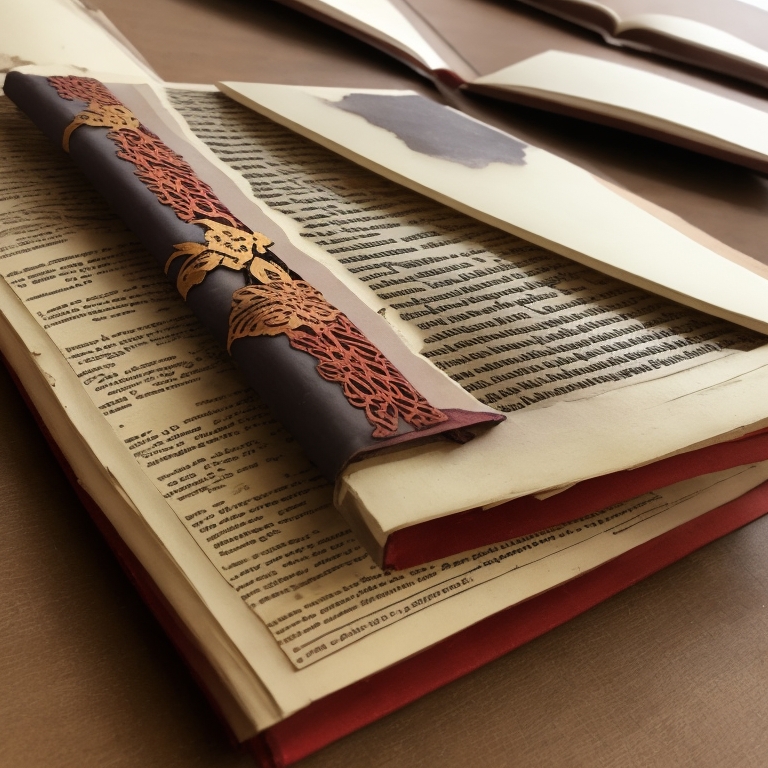Hey there, fellow bookworms! Have you ever wondered what goes into making a book and how to keep your favourite reads looking great for years to come? If so, you’re in luck because, in this article, we’ll be exploring the world of bookbinding and book preservation.
Books are more than just a collection of pages held together by a spine – they’re a cherished part of many of our lives, providing entertainment, knowledge, and comfort. And just like any other treasured possession, books require some TLC to stay in top shape.
In this article, we’ll dive into the history of bookbinding, explore the different types of bookbinding techniques, and talk about the materials used in bookbinding. We’ll also discuss the importance of book preservation and offer some DIY tips for keeping your books in good condition. Whether you’re a book collector, a librarian, or just a lover of the written word, this article has something for you.
So, grab a cup of tea, find a cosy spot to settle in, and let’s explore the wonderful world of bookbinding and book preservation!
The History of Bookbinding
Believe it or not, bookbinding has been around for thousands of years. In fact, some of the oldest surviving books in the world have been bound in elaborate covers made of materials like wood, leather, and even precious metals.
Throughout history, bookbinding techniques have evolved and changed to reflect the times. Early bookbinders would create covers by wrapping scrolls of papyrus or parchment around each other and stitching them together, creating what is known as a “codex.” Over time, bookbinding techniques became more sophisticated, with the use of tools like bone folders, awls, and sewing frames.
In the Middle Ages, illuminated manuscripts were bound in intricate covers made of gold leaf, precious stones, and embossed leather. During the Renaissance, bookbinding became more standardized, with the use of printed book blocks and simpler covers. In the 19th century, bookbinding became an art form in its own right, with bookbinders like William Morris and the Doves Bindery creating stunningly beautiful, handmade books.
Today, bookbinding continues to be an important part of the publishing industry, with a range of techniques and styles used to create books for all kinds of readers. From mass-produced paperbacks to bespoke, hand-bound volumes, there’s a bookbinding technique out there for every taste and budget.
Different Types of Bookbinding Techniques
When it comes to bookbinding, there are a ton of different techniques out there. Some are simple and straightforward, while others are more complex and time-consuming. Here are a few of the most common types of bookbinding techniques you might come across:
- Case binding: This is one of the most common types of bookbinding used for hardcover books. It involves glueing a book’s printed pages (also known as the “text block”) to a cover made of cardboard or another stiff material. The cover is then wrapped in fabric, paper, or leather.
- Perfect binding: This is a type of binding used for softcover books. It involves glueing the spine of a book’s pages together and then attaching a paper cover to the spine. This type of binding is often used for magazines, trade paperbacks, and other books that are meant to be read once and then disposed of.
- Saddle stitching: This type of binding is often used for booklets or small publications. It involves folding a set of pages in half and then stapling them together along the fold. This type of binding is often used for things like pamphlets, newsletters, or zines.
- Smyth sewing: This is a type of binding used for hardcover books that need to withstand a lot of wear and tear. It involves sewing the book’s pages together in small groups (also known as “signatures”) and then attaching the signatures to the spine of the cover. This type of binding creates a very durable book that can be opened and closed repeatedly without falling apart.
There are, of course, many other types of bookbinding out there, each with its own pros and cons. The type of binding used for a particular book depends on factors like the book’s intended use, its size, and its budget. Regardless of the technique used, though, a well-bound book is a joy to hold and read.
Materials Used in Bookbinding
When it comes to bookbinding, there are a wide variety of materials that can be used to create covers, spines, and pages. Here are a few of the most common materials used in bookbinding:
- Paper: This might seem obvious, but paper is actually one of the most important materials used in bookbinding. It’s used to create the pages of the book, as well as the endpapers that are glued to the inside covers. There are many different types of paper available for bookbinding, ranging from thin, delicate papers for fine art books to thicker, more durable papers for textbooks and reference books.
- Cloth: Cloth is often used to cover hardcover books and comes in a wide variety of colours and textures. It’s durable, relatively inexpensive, and can be easily stamped or embossed with designs or text.
- Leather: Leather is a popular choice for high-end bookbinding. It’s beautiful, durable, and comes in a variety of textures and colours. Leather-bound books are often used for special editions, gifts, or collections.
- Board: Board is used to create the cover of a hardcover book. It’s typically made of a type of cardboard and can be covered in cloth, paper, or leather. The thickness and stiffness of the board used depends on the size and intended use of the book.
- Thread: Thread is used to sew the signatures of a book together and is an important part of many bookbinding techniques. There are many different types of thread available for bookbinding, ranging from synthetic to natural and in a variety of colours.
- Glue: Glue is used to attach the pages of a book to the cover, as well as to attach the cover to the spine. There are many different types of glue available for bookbinding, each with its own strengths and weaknesses.
These are just a few of the many materials used in bookbinding. The type of material used depends on factors like the intended use of the book, the budget, and the desired aesthetic. Regardless of the materials used, though, a well-bound book is a work of art that can be treasured for years to come.
Book Preservation
Preserving books is an important part of bookbinding, particularly for books that are intended to be kept and cherished for a long time. Here are a few tips for preserving books:
- Keep books away from direct sunlight and heat: Exposure to sunlight and heat can cause pages to yellow, fade, and become brittle over time. Keep your books in a cool, dry place, and avoid placing them near windows or heat sources.
- Handle books with care: When handling a book, be gentle and avoid bending or folding the pages. Use a book stand or book weight to keep the book open when reading, rather than forcing it to stay open on its own.
- Store books properly: Store books upright on a shelf rather than laying them flat. This helps prevent the spine from becoming damaged or distorted. If a book is particularly valuable or fragile, consider storing it in a protective box or sleeve.
- Clean books carefully: Dust and debris can accumulate on the surface of books, which can be damaging over time. Use a soft, dry cloth to gently wipe the cover and pages of a book, being careful not to rub too hard or damage any delicate features like gilt or embossed designs.
- Repair books as needed: Over time, books can become damaged or start to fall apart. If a book is valuable or has sentimental value, consider having it repaired by a professional book conservator. They can repair damage to the spine, pages, or cover and help ensure that the book stays in good condition for years to come.
Preserving books is an important part of bookbinding and can help ensure that your favourite books stay in good condition for years to come. By following these tips, you can help keep your books in great shape and ensure that they can be enjoyed by future generations.
DIY Bookbinding and Preservation

If you’re interested in bookbinding and preservation, you might be wondering if it’s possible to do it yourself. The good news is that many DIY techniques can be used to create beautiful, well-bound books and preserve your favourite books at home. Here are a few tips for DIY bookbinding and preservation:
- Start small: If you’re new to bookbinding, it’s a good idea to start with a small project. For example, you might try creating a simple pamphlet-stitched notebook or a miniature book. This will help you get a feel for the materials and techniques used in bookbinding without being too overwhelming.
- Gather your materials: To create a well-bound book, you’ll need a few basic materials, like paper, thread, glue, and a cover material like cloth or leather. You can purchase these materials at a craft store or online.
- Learn basic bookbinding techniques: There are many different techniques used in bookbinding, from the basic pamphlet stitch to more advanced techniques like case binding. There are many tutorials and instructional videos available online that can help you learn these techniques.
- Preserve your existing books: In addition to creating new books, you can also use DIY techniques to preserve your existing books. For example, you might create a custom protective box or sleeve for a valuable book or repair a damaged spine or cover.
- Experiment and have fun: One of the best things about DIY bookbinding is that there are no rules. You can experiment with different materials, techniques, and designs to create a book that is truly unique and personalized. Don’t be afraid to make mistakes – sometimes, the best ideas come from happy accidents!
DIY bookbinding and preservation can be a fun and rewarding hobby, and can help you create beautiful, well-bound books that you can treasure for years to come. Whether you’re creating a new book from scratch or preserving an existing favourite, there’s no limit to what you can do with a little creativity and some basic materials. If you are interested Youtube has tons of DIY book-binding videos like this: perfect binding | step-by-step (no stitching & book press needed!)
Bookbinding and preservation are important skills that can help us create and maintain beautiful, long-lasting books. From the history of bookbinding to the materials used and techniques employed, there is so much to learn and explore in this fascinating field. Whether you’re a seasoned book lover or just getting started, there are many ways to get involved in bookbinding and preservation, from taking a class to experimenting with DIY techniques at home.
By understanding the basics of bookbinding and preservation, you can ensure that your favourite books stay in good condition for years to come. Whether you’re preserving a valuable antique or creating a custom journal for a friend, these skills can be both practical and deeply rewarding. So go ahead and dive in – the world of bookbinding and preservation is waiting for you!
Related posts
Archives
- May 2024 (1)
- June 2023 (1)
- May 2023 (3)
- January 2023 (1)
- December 2022 (1)
- July 2022 (1)
- June 2022 (7)
- May 2022 (1)
- April 2022 (1)
- March 2022 (2)
- February 2022 (2)
- December 2021 (1)
- October 2021 (2)
- September 2021 (11)
- August 2021 (25)

